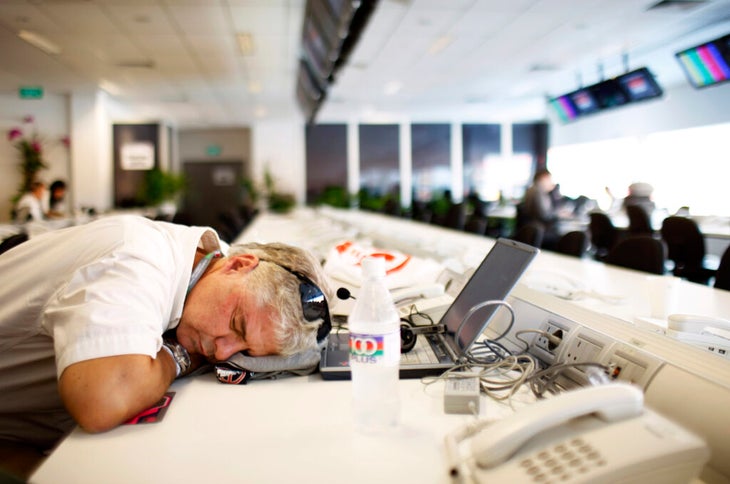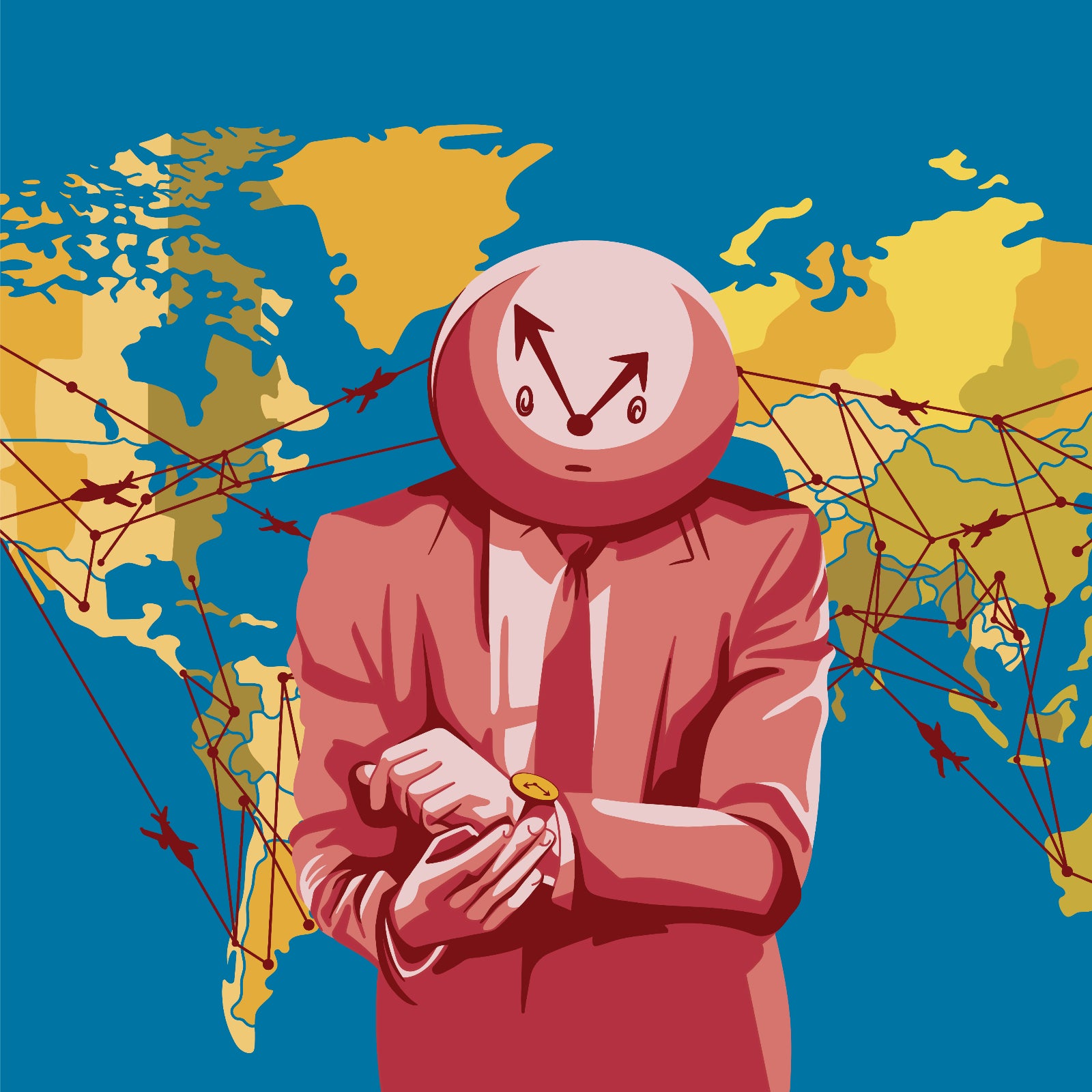My friends invited me on a ski trip to Chamonix, France, this winter, but the last time I flew to Europe my jet lag rivaled a hangover: for three days I had a pounding headache, my stomach was upset, and I couldn’t fall asleep at night. I’m worried I won’t be able to ski if I feel that terrible again. Is there any new jet lag research that can help me? At this point, I’m willing to try anything. —Leery of the Long Haul
Whether you’re planning an epic winter getaway or simply flying home for the holidays, you don’t want to start your trip feeling jet-lagged. The brain fog and fatigue that results from crossing time zones can be debilitating. Despite various “cures” circulating in the media for this dreaded condition, experts have yet to discover a consistent remedy for jet lag.
That said, there are plenty of strategies for reducing symptoms. As a longtime travel writer who typically hops on more than 20 overseas flights each year, I’ve tried everything from sensible strategies like avoiding alcohol and caffeine while on the plane to more out-there interventions like fasting on flights (I felt hyperalert, albeit famished, upon arrival) and sitting for an IV drip enriched with B and C vitamins at my hotel post-flight (I didn’t feel energized, but I wasn’t falling asleep at dinner either).
published in Chaos, an Interdisciplinary Journal of Nonlinear Science, suggests that the key to avoiding jet lag after a long-haul flight may be as simple as eating a big breakfast once you reach your destination. Breakfast is, after all, the most important meal of the day. But how legitimate are these study’s findings? Let’s back up a bit so I can explain the basics of jet lag, and then I’ll dive into the details of the big-breakfast theory.
What Is Jet Lag and How Long Does It Take to Get Over It?
Contrary to popular belief, jet lag isn’t caused by a lack of sleep. The defines the condition as “a temporary sleep problem that can affect anyone who quickly travels across multiple time zones.” Our body’s internal clock, which is regulated by 24-hour cycles of circadian rhythms, tells the body when to sleep and when to wake up. When we fly, our internal clock stays anchored in one time zone while we physically travel to another; this causes our bodies and our body clocks to fall out of sync with the daylight-nighttime schedule of our new destination.
For example, if you fly out of San Francisco on at 1 P.M. on Tuesday and touch down in Geneva, Switzerland, at 11:40 A.M. Wednesday, your internal clock still thinks it’s 3:40 A.M. when you arrive, due to the nine-hour time difference. So even though the sun is shining, as you go through the motions of retrieving your bags and setting off on the hourlong drive to Chamonix, to your body it’s still basically the middle of the night.
Jet lag affects people differently. In general, the more time zones you cross, the longer it takes for your body to adjust, says Dr. Yitong Huang, a postdoctoral fellow at Northwestern University’s Braun Lab and coauthor of the new breakfast study. Our internal circadian clock can shift approximately one and a half hours per day at most, she says. So it might take a week or more for your body to adjust to Europe. However, if you’re only experiencing a two-hour difference, your body can adjust within a day or two.
Medical experts generally agree that flying eastward tends to cause more severe jet-lag symptoms than flying west, because your body adapts more quickly to staying up late than going to bed earlier than normal. To alleviate adverse effects, the Mayo Clinic suggests going to bed one hour earlier each night for a few days before you fly east, and head to bed one hour later for several nights ahead of travel if you’re flying west. I’ve had success adjusting my schedule a few days ahead of traveling to match my destination’s new time zone by adhering to this practice.

Anyone who has suffered from jet lag can tell you it’s tough. According to the Cleveland Clinic, typical symptoms include daytime drowsiness, insomnia, fatigue, headaches, lack of concentration, an upset stomach, and mood swings. If your body is extremely sensitive, you might feel the effects of jet lag after crossing just two time zones.
Additionally, a plane’s elevation and pressure, as well as the cabin’s incredibly dry atmosphere, can exacerbate jet lag, which is why keeping hydrated is crucial. Ordering a cocktail may seem like the perfect way to celebrate the start of your vacation, but it will likely sabotage your trip, because beverages with alcohol and caffeine disrupt sleep.
Could a Hearty Breakfast Be the Secret to Avoiding Jet Lag?
We’ve long known that light plays a central role in regulating circadian rhythm. When light enters the eye, it’s recognized by a special group of cells on the retina, which provide feedback to our brain about whether it’s day or night. This is why experts recommend getting at least ten minutes of sunlight exposure within 30 to 60 minutes of waking when you travel, and avoiding bright light at night, particularly between 10 P.M. and 4 A.M. in a new destination; both help you realign your circadian rhythm.
But other external cues, including exercise and food, also have an influence on our bodies. Huang, along with fellow researchers from Northwestern University and the Santa Fe Institute, built a mathematical model to explore how food and light play a role in determining how travelers can best reset themselves in a new time zone. “There’s a greater physiological sensitivity to time cues, such as light and food, earlier in the day,” she explains.
The team’s computational experiments studied trips that crossed six time zones and compared varying meal times and calories, including following your same eating schedule as back home and ignoring the new time zone; eating a big breakfast in the morning at your new location, and then a light lunch and light dinner later; and eating three evenly portioned meals throughout the day.
Results suggested that adjusting your meal schedule during the daytime in your new destination more effectively synchronizes circadian rhythms than having evenly spaced meals. And while your body adjusts during the first three days, adopting the practice of having a big breakfast in the morning of your new location, followed by lunch and dinner, was better than having three meals with similar caloric totals.
Further, avoiding evening meals for the first three days is helpful to overcome time differences of up to six hours. So if you’re heading to France, you may want to book that Michelin-starred splurge meal toward the end of your trip and instead spend the first few days indulging at breakfast with pain au chocolates and crepes.
What Exactly Constitutes a Big Breakfast?

Because this data was derived from a mathematical model, hearty doesn’t translate to a prescribed number of calories or nutrients, said Huang. The model simply predicts that consuming foods with more calories earlier in the day is better than eating regularly spaced meals or eating at night.
on circadian rhythms and diet as related to weight-loss outcomes and meal timing have shown that our bodies tend to prefer more calories earlier in the day. This may mean getting in as much as 30 to 50 percent of your daily calories at breakfast, says Natalie Romito, a registered dietician with Cleveland Clinic’s Center for Human Nutrition.
There’s a greater physiological sensitivity to time cues, such as light and food, earlier in the day.
Kesha Ahlo, a dietician and flight attendant with Hawaiian Airlines, says she always battles jet lag by consuming a meal that has a balance of protein, carbohydrates, and fats a few hours after waking in a new time zone. This may look like a couple of hard-boiled eggs with sausage and fruit, or cold overnight oats with nut butter, chia seeds, fruit, and Greek yogurt. “I find this gives my body the energy it needs to start the day, rather than pushing forward through fatigue,” she says.
Although the study discourages meals at night, she personally finds it helpful to have something light if she’s hungry when she arrives at night, to avoid waking too soon due to hunger.
Romito suggests packing pistachios in your carry-on. Not only are they a healthy snack, but they’re also a dietary source of melatonin, a hormone made naturally by your body to promote sleep. And if you’re arriving at night and plan to hit the sack, think twice; Romito says it’s best to have at least four hours between consuming alcohol and going to bed if you’re intent on getting a good night’s rest.
As for the hearty breakfast: you may not like to consume a big meal first thing in the morning, but if you can ward off feeling lousy when you travel just by starting your day with some avocado toast and eggs, I say it’s worth trying to be a breakfast person—at least for a few days.

���ϳԹ��� correspondent Jen Murphy loves eating a big breakfast whether she’s at home or away. Her personal secret to avoiding jet lag: a long run or yoga session upon arrival, followed by a strong coffee and, ideally, a breakfast of eggs, avocado, greens, and grains. In more far-flung locales, she packs protein bars as her breakfast safety net. She now plans to add pistachios to her packing list.


